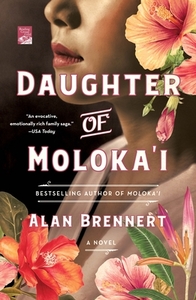Take a photo of a barcode or cover
emotional
informative
inspiring
sad
medium-paced
Plot or Character Driven:
A mix
Strong character development:
Yes
Loveable characters:
Yes
Diverse cast of characters:
Yes
Flaws of characters a main focus:
No
In "Moloka'i", Alan Brennert tells the story of Rachel, a young Hawaiian girl with leprosy who is removed from her family and taken to live at Moloka'i. We learn about this sad time in history through Rachel's eyes, including when she had a baby girl, and had to give her up so she would not pass her disease to her child. In this follow up novel, Brennert focuses on Ruth, Rachel's daughter, and the life she leads, from her time in the orphanage, to adoption and moving to California, to her time in the Japanese internment camps during World War II, and beyond.
Brennert is a talented author, and while I enjoyed the first novel just a little bit better, this one was still a compelling read that held my attention. As an adoptee myself, stories that involve adoption are close to my heart, even if they are often somewhat romanticized in fiction. I enjoyed the book, and I am eager to read "Honolulu" next, to continue reading this author's works.
Brennert is a talented author, and while I enjoyed the first novel just a little bit better, this one was still a compelling read that held my attention. As an adoptee myself, stories that involve adoption are close to my heart, even if they are often somewhat romanticized in fiction. I enjoyed the book, and I am eager to read "Honolulu" next, to continue reading this author's works.
I think this whole little series is well summed up by this quote:
"In Hawai'i I was honored to hear long, beautiful meles- songs or chants- joyously singing the history of an Ohana, a family, going back twenty generations or more. It is like hearing a chorus of voices singing across time itself. You have a Japanese legacy... but our blood is not your blood, no matter how much we love you and you love us. You have songs to hear from your Hawaiian mother, and songs to be revealed, perhaps, of your Japanese father... I cannot wait to hear the songs you sing back to us."
"In Hawai'i I was honored to hear long, beautiful meles- songs or chants- joyously singing the history of an Ohana, a family, going back twenty generations or more. It is like hearing a chorus of voices singing across time itself. You have a Japanese legacy... but our blood is not your blood, no matter how much we love you and you love us. You have songs to hear from your Hawaiian mother, and songs to be revealed, perhaps, of your Japanese father... I cannot wait to hear the songs you sing back to us."
Daughter of Moloka’i is the sequel to Alan Brennart’s novel. Sometimes sequels dont live up to the first book but after reading Daughter Of Moloka’i this was not the case. This beautiful story lived up to Moloka’i. The images i could see from these books will live in my memory for quite awhile,
Possibly Brennart’s greatest gift to the novel is his ability to deeply and deftly describe the places and people so that we are transported to that time and local. We emotionally connect with Ruth. We feel her sadness, we celebrate her joy and fulfillment. We won’t forget her. You can’t ask for more than that in a novel.
Possibly Brennart’s greatest gift to the novel is his ability to deeply and deftly describe the places and people so that we are transported to that time and local. We emotionally connect with Ruth. We feel her sadness, we celebrate her joy and fulfillment. We won’t forget her. You can’t ask for more than that in a novel.
emotional
hopeful
informative
inspiring
reflective
sad
slow-paced
Plot or Character Driven:
A mix
Strong character development:
Yes
Loveable characters:
Yes
Diverse cast of characters:
Yes
Flaws of characters a main focus:
Yes
The sequel to Moloka’i, it tells Ruth’s story. Ruth is the daughter of Rachel Kalama, the protagonist of the first book. Rachel is forced to give Ruth away at birth so as not to infect her with leprosy.
Ruth arrives at the Kapi’olani Home for Girls in Honolulu where her journey in this book begins. It later follows her adoption by a Japanese couple from Hawaii who eventually move with her to California. Then Pearl Harbor is bombed and the Japanese, including Ruth and her extended family, are rounded up and sent to internment camps where they live in terrible conditions. After they are finally released they have to rebuild their lives, more or less starting from scratch. It is while they are rebuilding their life in California that Ruth is reunited with Rachel.
I loved the first part of the book and found the historical truths of the racism faced by Japanese terrible, but important and interesting to read. But the second half is great as well. It becomes a completely different story: a story of mother and daughter, of two strong women who never thought they would meet.
A heartbreaking main theme of the book is illustrated in Rachel’s dismay at what happened to Ruth in the internment camps. Her first reaction was, "OH NO!! YOU were supposed to be FREE!!" Having read both Molokai and Daughter of Molokai, I see the parallel storylines of trials and tribulations with families trying to make the best of the worst situations when government entities are controlling them. Both great reads!
An excellent book that spans the life of a girl born on Moloka'i. She was adopted by a Japanese family and spent her youth on Oahu. Her family moved to California where she married. She and her extended family were sent to a Japanese internment camp. Once released, they return to Florin where they lived before the internment. Eventually, they move to the bay area where she reads a letter sent from her birth mother to her adoptive mother. In some ways, I think this sequel is better than Moloka'i. Read them both, you won't be disappointed!
On a rainy night, a baby is brought to an orphanage with the hopes of a safe haven and a better life. Ruth is a determinedly upbeat girl, a lover of animals who can be crushed by loss but finds hope again and again. This is her story. And it’s the story of a half Japanese half Hawaiian girl who takes the reader from Hawaii to California. Again, the author has created a world that is both engaging and horrific. The racism on the west coast that finds a home after Pearl Harbor in the Japanese internment camps is a dismal chapter in our history. The Asian culture, the filial duty of Japanese children and the importance of honor in the Japanese culture clash how the US Japanese citizens were treated in the early 40’s. And the Hawaiian culture and outlook may prove to offer more comfort to Ruth once she and her family are released and she faces more. This book is both a follow up to Moloka’i and a continuation of Rachel’s story. It’s a story that it told with care and illuminates both cruelty and strength.
challenging
emotional
reflective
slow-paced
informative
sad
medium-paced
Plot or Character Driven:
A mix
Strong character development:
Yes
Loveable characters:
Yes
Diverse cast of characters:
Yes
Flaws of characters a main focus:
Yes
A sequel to the much beloved book Moloka'I (that I have yet to read) this book narrates the captivating story of Ruth, who is separated shortly after her birth from her Hawaiian mother and Japanese father, both of whom suffer from Hansen’s disease. As she is disease-free, she is sent to an orphanage where after having almost given up all hopes of ever being adopted, a Japanese couple fall in love with her and take her home. The story carries on over for some fifty or so years documenting the challenges and tragedies people of Japanese ancestry had to face in America before, during, and after the World War II when they were punished for being who they were and not for any “other” wrong doing.
To say that this book was an enlightening read for me would be a gross understatement. The author very well touches upon a range of issues centering the South-Asian migrant experience, as well as the horrible cruelty of internment camps that were set up to cast-out Japanese Americans after the Pearl harbor attack.
This story was my introduction to the beautiful and colorful culture of Hawaii and made for a very gripping read.
I would have appreciated the story even more if the characters were sketched out as a bit more multi-dimensional and the long-winded narrative and big jumps in the timeframe avoided.
Also, one more thing that stood out for me is that though this book is historically quite relevant, the show-rather-than-tell approach would have better woven it into the story.
I really enjoyed this book and would recommend it specially, the parts about the precious little Ruth.
“Her grief was a storm, a driving rain falling too fast to be absorbed”
To say that this book was an enlightening read for me would be a gross understatement. The author very well touches upon a range of issues centering the South-Asian migrant experience, as well as the horrible cruelty of internment camps that were set up to cast-out Japanese Americans after the Pearl harbor attack.
This story was my introduction to the beautiful and colorful culture of Hawaii and made for a very gripping read.
I would have appreciated the story even more if the characters were sketched out as a bit more multi-dimensional and the long-winded narrative and big jumps in the timeframe avoided.
Also, one more thing that stood out for me is that though this book is historically quite relevant, the show-rather-than-tell approach would have better woven it into the story.
I really enjoyed this book and would recommend it specially, the parts about the precious little Ruth.
“Her grief was a storm, a driving rain falling too fast to be absorbed”




